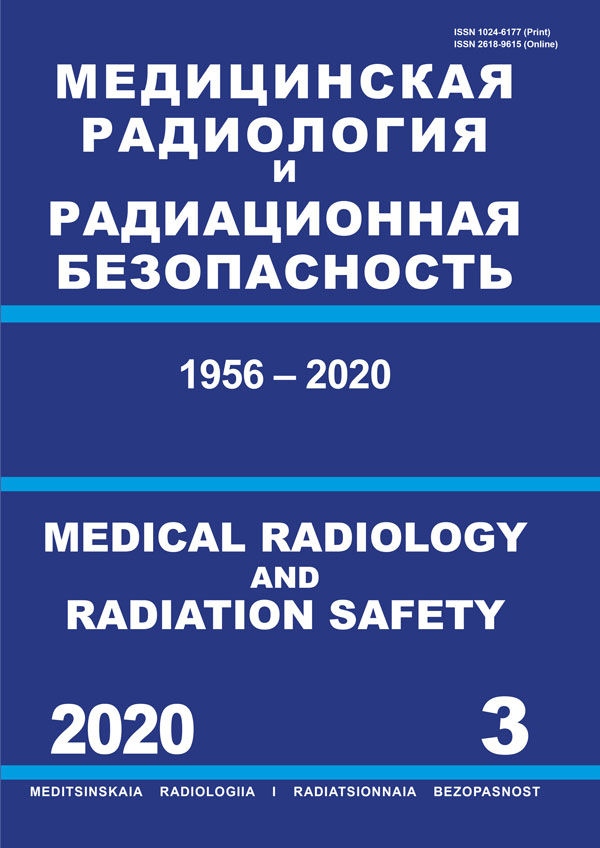UDK 61 Медицина. Охрана здоровья
GRNTI 76.29 Клиническая медицина
Purpose: To determine frequency-dependent impedance characteristics of the brains of the experimental animals. Material and methods: The developed by us 2-microphone interferometer technology was used in the acoustic impedance characteristics determination. The two standard microphones mounted stationary on a lateral surface of the interferometer measure the sound pressure levels and the phase difference between them. According to these data, the complex reflection coefficient and the impedance components of the test sample mounted on the end of the interferometer are calculated. The electrical impedance characteristics were measured by two electrodes method with the usage of parallel electrodes. The sample was placed between two electrodes and values of electrical impedance were detected by the electric current flowing through them. The object of the investigation was the rabbit brain. Results: The maximum acoustic absorption coefficient of the rabbit’s brain, on average, is registered at a frequency of 160–180 Hz and reaches 0.7. Then, as the frequency increases, the absorption coefficient decreases and at an average frequency of 760 Hz is 0.43. It can be noted that the spread in the data is maximum in the frequency range up to 240 Hz. The coefficient of variation varies from 23 to 10 %. At frequencies above 300 Hz, the coefficient of variation is less than 5 %. A low value of the coefficient of variation indicates a sufficiently accurate and reliable data. The difference in the magnitude of the spread between low frequencies in comparison with the spreads at medium and high frequencies reaches 2–4 times. This difference is caused by methodological errors. First of all, this is due to the fact that the waveguide is round with a diameter equal to 3.3 cm, and the whole brain of the rabbit resembles in a greater degree an oval. It is impossible for the rabbit’s whole brain to completely cover the circular surface of the waveguide section, there will always be gaps that bring in an element of uncertainty at low frequencies. At higher frequencies, this circumstance no longer affects the measurement error significantly. The presence of a maximum at frequencies of 160–180 Hz does not correspond to theoretical concepts. With the help of additional experiments with non-biological samples, it was possible to establish that this maximum is caused by an irregular geometric shape of the rabbit’s whole brain. Depending on the position of small dimples in the brain tissue and other irregularities, the maximum of the absorption coefficient appears. Those it is also a methodological error that characterizes rather the degree of overlapping of the waveguide section and the contact surface of the sound wave with the brain. In this series of experiments, it was also estimated how the values of the acoustic characteristics of the brain of rabbits vary with time. The first measurements were made 10–15 minutes after the extraction of the brain, the second measurement after 20 minutes, the third after 1 hour. It can be noted that the average values are almost identical starting from frequencies from 300 Hz and higher. There are small deviations in the readings at low frequencies. Over time, the absorption coefficient at low frequencies increased from 0.65 to 0.75. The analysis of the electrical impedance characteristics and loss factor calculations indicates that the range of the loss factor variation at a frequency of 1 kHz, for all experimental animals ranges from 0.04 to 0.07 and at a frequency of 100 kHz – from 0.06 to 0.09. Conclusion: The represented measuring systems allow obtaining the necessary acoustic and electrical impedance characteristics of biotissues; these data are important for the physical and mathematical modelling of the sound and EM waves’ interaction with the human body.
impedance, loss coefficient, absorption coefficient, resistivity, acoustical impedance, electrical impedance, 2-microphone technology, two electrodes method, brain, rabbits
В соответствии с данными Всемирной организации здравоохранения, средний уровень влияния окружающей среды на здоровье населения достигает 17–20 %, из них 16 % заболеваемости обусловлено акустическим загрязнением среды обитания. Научно-технический прогресс, развитие и внедрение новых технологий ведут к возрастанию энерговооруженности и, как следствие, повышенному уровню шума и электромагнитного поля (ЭМП), сопровождающих человека в его повседневной жизни как на производстве, так и в быту. В связи с невозможностью проведения радикальных мероприятий по снижению уровней шума и ЭМП в источнике образования имеется насущная необходимость в разработке медико-технических мероприятий по защите населения от вредного влияния указанных физических факторов окружающей среды.
1. Dragan S.P., Lebedeva I.V. Determination of acoustic characteristics in pipes using two microphones // Izmeritelnaya Tekhnika (‘Measurement Techniques’). 1988. № 8. P. 52-58. (In Russian. English abstracts. PubMed)
2. Dragan S.P., Lebedeva I.V. Determination of the intensity of the flat sound wave// Akusticheskij Zhurnal (‘Acoustic Journal’). 1992. № 2. P. 174-178. (In Russian. English abstracts. PubMed)
3. Dragan S.P., Bogomolov A.V., Erofeev, G.G. Device for measuring the acoustic impedance of the middle ear. Patent for invention RU № 2572156. 27.12.2015. (In Russian)
4. Dragan S.P., Bogomolov A.V., Erofeev, G.G. Device for impedance studies of respiratory function. The patent for utility model RU No. 148484, 31.07.2014. (In Russian)
5. Berezovskaya G.E., Korytnyj V.S. The role of near-electrode polarization processes in the measurement of electrical conductivity of biological objects // Biofizika (‘Biophysics’). 1968. Vol. 13. № 3. P. 524-528. (In Russian. English abstracts. PubMed)
6. Tikhomirov A. M. Impedance of biological tissues and its application in medicine. - Russian State Medical University. 2006. 12 pp. (In Russian)





